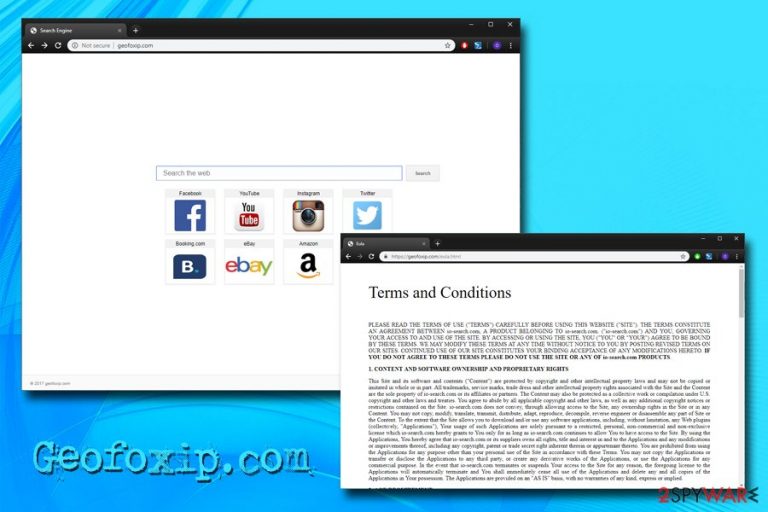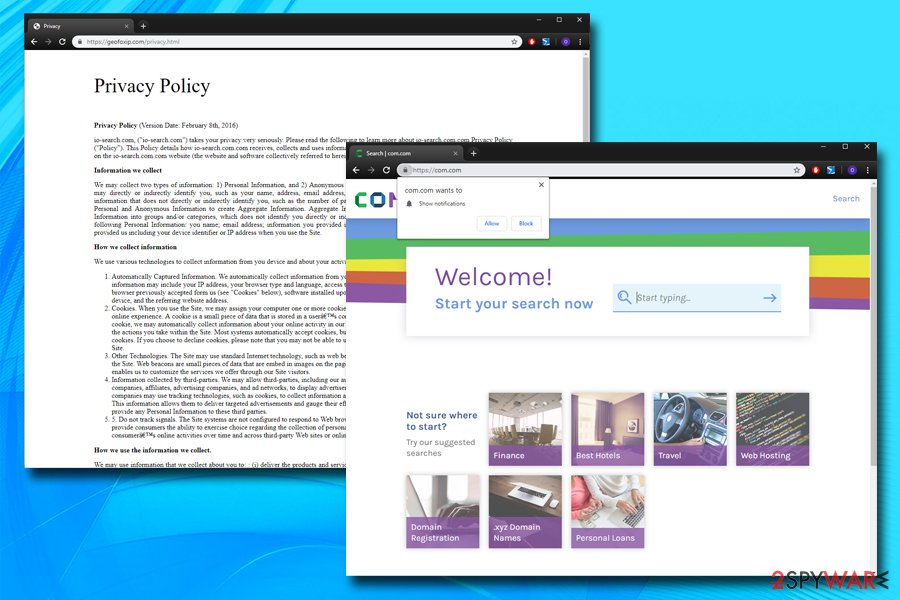Geofoxip.com (Removal Guide) - Chrome, Firefox, IE, Edge
Geofoxip.com Removal Guide
What is Geofoxip.com?
Geofoxip.com is the search engine that claims to offer valuable service while it triggers redirects and intrusive ads istead

Geofoxip.com is a potentially unwanted program that enters machine without users' notice and changes the settings of Google Chrome, Safari, Mozilla Firefox, or another browser. As soon as that happens, users can notice that their homepage and new tab address are set to hxxps://geofoxip.com.
Since the primary goal of Geofoxip.com hijack is to expose users to the affiliated content, the potentially unwanted program starts by showing users alternative search results to what they would typically see on search engines like Google, Bing, or Yahoo. Additionally, the sponsored links at the top of the results artificially increase the rank of predetermined sites, making users more likely to visit them.
| Name | Geofoxip.com |
| Type | Browser hijacker, redirect virus |
| Category | Potentially unwanted program |
| Developer | io-search.com |
| Infiltration | Software bundles, third-party sites |
| Risk factors | Installation of other potentially unwanted programs, money loss |
| Termination | Use antivirus software or our removal guide below |
| Recovery | To make sure your PC runs well after the infection, scan it with FortectIntego |
The presence of Geofoxip.com might also result in privacy issues, as certain information about users is being tracked at all times, as long as the hijacker is present on the computer. This is done in order to show users targeted advertisement,[1] further increasing chances of them visiting sponsored sites.
Browser hijackers like this function very similarly, as they change web browser settings without permission and alter their settings. From that time, users are forced to search for the information via the hijacked browser, and they cannot set their preferred settings until Geofoxip.com removal is performed.
Additionally, users might also notice an increased amount of ads on all websites that they visit, even those that usually do not serve pop-ups, pop-unders, in-text links, deals, banners, etc. Unfortunately, clicking on the induced links might lead users to an insecure site that try to sell bogus software or scam them by displaying technical support scams. The latter might result in excessive money loss, as well as remote malware[2] installation by crooks.
Therefore, if you see suspicious ads while browsing, never click on them. Simply leave the site or keep browsing while being careful. To stop the unwanted ads, you will have to remove the redirect virus from your device – you will also be able to restore web browser settings after that.

Finally, you should remember that Geofoxip.com browser hijacker collects not only anonymous but also personal information, as it is explained in the Privacy Policy:[3]
We may collect two types of information: 1) Personal Information, and 2) Anonymous Information. Personal Information means information that may directly or indirectly identify you, such as your name, address, email address, and telephone number. Anonymous Information means information that does not directly or indirectly identify you, such as the number of page views, link clicks, and login times. We may use both Personal and Anonymous Information to create Aggregate Information.
This data helps Geofoxip.com to earn money, but users are exposing their personal information to unknown third-parties, which can cause privacy issues. Thus, terminate the PUP from your computer as soon as possible, reset your browsers and then scan your computer with SpyHunter 5Combo Cleaner, Malwarebytes for best results.
Pre-packed software allows these intruders to find their way on the system
The biggest mistake that people make when installing free software from the internet is picking Recommended/Quick settings. This is because users are convinced that quick installation process will be simply faster. However, this is the easiest way to install potentially unwanted programs without noticing.
Software bundling is a well-known PUP distribution technique and has been used for years. Freeware and shareware developers are interested in including additional components within their installation wizards, as every install is paid for by PUP authors. Thus, Recommended/Quick settings help them hide PUPs; the full list of the programs can be uncovered by picking Advanced/Custom settings.

Additionally, you should also make sure you have security software installed, as many vendors are now recognizing potentially unwanted programs and prevent its infiltration in the first place.
Finally, third-party sites can often promote PUPs as legitimate and useful applications, so users might install them intentionally. To avoid that, make sure you read up on the app you are about to install – reviews and forum posts can often serve as a great hint whether or not it is actually useful.
Get rid of the Geofoxip.com either manually or automatically
To remove the redirect virus, you will have to either install anti-virus software or make use of our guide below. While the latter can be just as effective removing a particular unwanted application, some PUPs might be quite deceptive. In such a case, you should opt for automatic option.
Once Geofoxip.com removal is complete, please make sure you reset each of the installed browsers. This is because browser hijackers alter web browser settings and install cookies, so intrusive ads and redirects might not go away, even if you terminate the initial unwanted application.
You may remove virus damage with a help of FortectIntego. SpyHunter 5Combo Cleaner and Malwarebytes are recommended to detect potentially unwanted programs and viruses with all their files and registry entries that are related to them.
Getting rid of Geofoxip.com. Follow these steps
Uninstall from Windows
Instructions for Windows 10/8 machines:
- Enter Control Panel into Windows search box and hit Enter or click on the search result.
- Under Programs, select Uninstall a program.

- From the list, find the entry of the suspicious program.
- Right-click on the application and select Uninstall.
- If User Account Control shows up, click Yes.
- Wait till uninstallation process is complete and click OK.

If you are Windows 7/XP user, proceed with the following instructions:
- Click on Windows Start > Control Panel located on the right pane (if you are Windows XP user, click on Add/Remove Programs).
- In Control Panel, select Programs > Uninstall a program.

- Pick the unwanted application by clicking on it once.
- At the top, click Uninstall/Change.
- In the confirmation prompt, pick Yes.
- Click OK once the removal process is finished.
Delete from macOS
Remove items from Applications folder:
- From the menu bar, select Go > Applications.
- In the Applications folder, look for all related entries.
- Click on the app and drag it to Trash (or right-click and pick Move to Trash)

To fully remove an unwanted app, you need to access Application Support, LaunchAgents, and LaunchDaemons folders and delete relevant files:
- Select Go > Go to Folder.
- Enter /Library/Application Support and click Go or press Enter.
- In the Application Support folder, look for any dubious entries and then delete them.
- Now enter /Library/LaunchAgents and /Library/LaunchDaemons folders the same way and terminate all the related .plist files.

Remove from Microsoft Edge
Delete unwanted extensions from MS Edge:
- Select Menu (three horizontal dots at the top-right of the browser window) and pick Extensions.
- From the list, pick the extension and click on the Gear icon.
- Click on Uninstall at the bottom.

Clear cookies and other browser data:
- Click on the Menu (three horizontal dots at the top-right of the browser window) and select Privacy & security.
- Under Clear browsing data, pick Choose what to clear.
- Select everything (apart from passwords, although you might want to include Media licenses as well, if applicable) and click on Clear.

Restore new tab and homepage settings:
- Click the menu icon and choose Settings.
- Then find On startup section.
- Click Disable if you found any suspicious domain.
Reset MS Edge if the above steps did not work:
- Press on Ctrl + Shift + Esc to open Task Manager.
- Click on More details arrow at the bottom of the window.
- Select Details tab.
- Now scroll down and locate every entry with Microsoft Edge name in it. Right-click on each of them and select End Task to stop MS Edge from running.

If this solution failed to help you, you need to use an advanced Edge reset method. Note that you need to backup your data before proceeding.
- Find the following folder on your computer: C:\\Users\\%username%\\AppData\\Local\\Packages\\Microsoft.MicrosoftEdge_8wekyb3d8bbwe.
- Press Ctrl + A on your keyboard to select all folders.
- Right-click on them and pick Delete

- Now right-click on the Start button and pick Windows PowerShell (Admin).
- When the new window opens, copy and paste the following command, and then press Enter:
Get-AppXPackage -AllUsers -Name Microsoft.MicrosoftEdge | Foreach {Add-AppxPackage -DisableDevelopmentMode -Register “$($_.InstallLocation)\\AppXManifest.xml” -Verbose

Instructions for Chromium-based Edge
Delete extensions from MS Edge (Chromium):
- Open Edge and click select Settings > Extensions.
- Delete unwanted extensions by clicking Remove.

Clear cache and site data:
- Click on Menu and go to Settings.
- Select Privacy, search and services.
- Under Clear browsing data, pick Choose what to clear.
- Under Time range, pick All time.
- Select Clear now.

Reset Chromium-based MS Edge:
- Click on Menu and select Settings.
- On the left side, pick Reset settings.
- Select Restore settings to their default values.
- Confirm with Reset.

Remove from Mozilla Firefox (FF)
Remove dangerous extensions:
- Open Mozilla Firefox browser and click on the Menu (three horizontal lines at the top-right of the window).
- Select Add-ons.
- In here, select unwanted plugin and click Remove.

Reset the homepage:
- Click three horizontal lines at the top right corner to open the menu.
- Choose Options.
- Under Home options, enter your preferred site that will open every time you newly open the Mozilla Firefox.
Clear cookies and site data:
- Click Menu and pick Settings.
- Go to Privacy & Security section.
- Scroll down to locate Cookies and Site Data.
- Click on Clear Data…
- Select Cookies and Site Data, as well as Cached Web Content and press Clear.

Reset Mozilla Firefox
If clearing the browser as explained above did not help, reset Mozilla Firefox:
- Open Mozilla Firefox browser and click the Menu.
- Go to Help and then choose Troubleshooting Information.

- Under Give Firefox a tune up section, click on Refresh Firefox…
- Once the pop-up shows up, confirm the action by pressing on Refresh Firefox.

Remove from Google Chrome
Delete malicious extensions from Google Chrome:
- Open Google Chrome, click on the Menu (three vertical dots at the top-right corner) and select More tools > Extensions.
- In the newly opened window, you will see all the installed extensions. Uninstall all the suspicious plugins that might be related to the unwanted program by clicking Remove.

Clear cache and web data from Chrome:
- Click on Menu and pick Settings.
- Under Privacy and security, select Clear browsing data.
- Select Browsing history, Cookies and other site data, as well as Cached images and files.
- Click Clear data.

Change your homepage:
- Click menu and choose Settings.
- Look for a suspicious site in the On startup section.
- Click on Open a specific or set of pages and click on three dots to find the Remove option.
Reset Google Chrome:
If the previous methods did not help you, reset Google Chrome to eliminate all the unwanted components:
- Click on Menu and select Settings.
- In the Settings, scroll down and click Advanced.
- Scroll down and locate Reset and clean up section.
- Now click Restore settings to their original defaults.
- Confirm with Reset settings.

Delete from Safari
Remove unwanted extensions from Safari:
- Click Safari > Preferences…
- In the new window, pick Extensions.
- Select the unwanted extension and select Uninstall.

Clear cookies and other website data from Safari:
- Click Safari > Clear History…
- From the drop-down menu under Clear, pick all history.
- Confirm with Clear History.

Reset Safari if the above-mentioned steps did not help you:
- Click Safari > Preferences…
- Go to Advanced tab.
- Tick the Show Develop menu in menu bar.
- From the menu bar, click Develop, and then select Empty Caches.

After uninstalling this potentially unwanted program (PUP) and fixing each of your web browsers, we recommend you to scan your PC system with a reputable anti-spyware. This will help you to get rid of Geofoxip.com registry traces and will also identify related parasites or possible malware infections on your computer. For that you can use our top-rated malware remover: FortectIntego, SpyHunter 5Combo Cleaner or Malwarebytes.
How to prevent from getting browser hijacker
Access your website securely from any location
When you work on the domain, site, blog, or different project that requires constant management, content creation, or coding, you may need to connect to the server and content management service more often. The best solution for creating a tighter network could be a dedicated/fixed IP address.
If you make your IP address static and set to your device, you can connect to the CMS from any location and do not create any additional issues for the server or network manager that needs to monitor connections and activities. VPN software providers like Private Internet Access can help you with such settings and offer the option to control the online reputation and manage projects easily from any part of the world.
Recover files after data-affecting malware attacks
While much of the data can be accidentally deleted due to various reasons, malware is one of the main culprits that can cause loss of pictures, documents, videos, and other important files. More serious malware infections lead to significant data loss when your documents, system files, and images get encrypted. In particular, ransomware is is a type of malware that focuses on such functions, so your files become useless without an ability to access them.
Even though there is little to no possibility to recover after file-locking threats, some applications have features for data recovery in the system. In some cases, Data Recovery Pro can also help to recover at least some portion of your data after data-locking virus infection or general cyber infection.
- ^ Targeted advertising. Wikipedia. The free encyclopedia.
- ^ Lucia Danes. Computer viruses and malware. 2-spyware. Cybersecurity news and articles.
- ^ Privacy Policy. Geofoxip.com. Official website.
